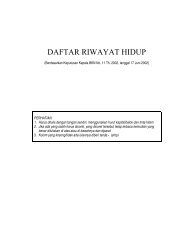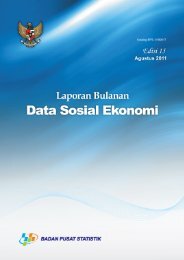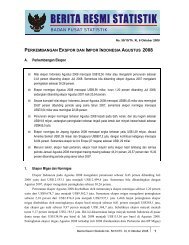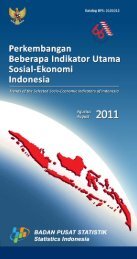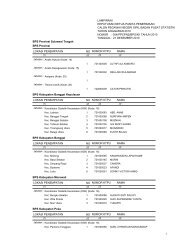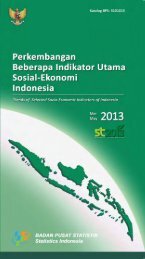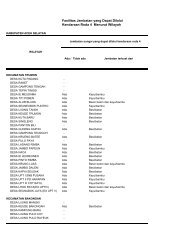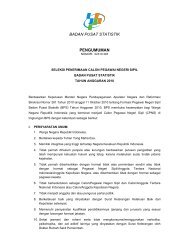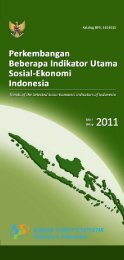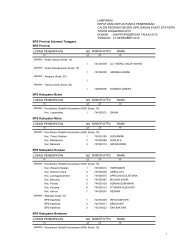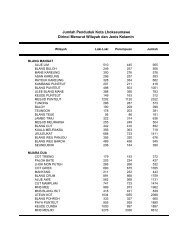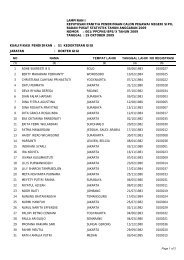Trends of Selected Socio-Economic Indicators of Indonesia, August ...
Trends of Selected Socio-Economic Indicators of Indonesia, August ...
Trends of Selected Socio-Economic Indicators of Indonesia, August ...
You also want an ePaper? Increase the reach of your titles
YUMPU automatically turns print PDFs into web optimized ePapers that Google loves.
Technical Explanation <strong>of</strong><br />
<strong>Selected</strong> <strong>Socio</strong>-<strong>Economic</strong> <strong>Indicators</strong> <strong>of</strong> <strong>Indonesia</strong><br />
This booklet is arranged by choosing some statistical data and information which<br />
have been published by Statistics <strong>Indonesia</strong> (Badan Pusat Statistik) in Statistical Yearbook<br />
<strong>of</strong> <strong>Indonesia</strong>, <strong>Economic</strong> <strong>Indicators</strong>, and other publications.<br />
To help the users, the statistical data and information are grouped into 10 categories<br />
and then followed by technical explanation <strong>of</strong> the definitions and glossaries used in each<br />
category. The catagories are as followed.<br />
1. Geographical Situation includes: number <strong>of</strong> administrative units, and total area<br />
province.<br />
2. Population and Man Power: Data on population includes: population density,<br />
population by age group, population growth rate. Data on labor force includes:<br />
number <strong>of</strong> unemployment, wages/salaries, and minimum standard <strong>of</strong> living.<br />
3. Social includes: birth rate, live expectancy, children under-five years, education,<br />
human development index, source <strong>of</strong> drinking water, and poverty.<br />
4. Expenditures includes: food and non-food expenditures.<br />
5. Agriculture includes: harvested area and agricultural production <strong>of</strong> food crops,<br />
horticulture, livestock, fishery and forestry.<br />
6. Manufacturing and Construction include: Production Indices <strong>of</strong> large and medium<br />
manufacturing and construction.<br />
7. Foreign Trade includes: exports by country <strong>of</strong> destination, by commodities, oil and<br />
non-oil exports, imports by country <strong>of</strong> origin, and balance <strong>of</strong> trade.<br />
8. Tourism and Transportation: Data on tourism include: number <strong>of</strong> tourist by country<br />
<strong>of</strong> residence, length <strong>of</strong> stay, room occupancy rate; data on transportation includes:<br />
number <strong>of</strong> passengers and goods.<br />
9. Finance and Prices include: government budget expenditure, monetary, foreign<br />
currencies, consumer price indices, inflation, wholesale price indices, farmer’s terms<br />
<strong>of</strong> trade, consumer tendency index and business tendency index.<br />
10. National and Regional Income include: Gross Domestic Product, Gross Regional<br />
Domestic Product, and per capita national income.<br />
Some concepts and definitions used in this booklet:<br />
• Administrative area is an area, which legalized by Ministry <strong>of</strong> Home Affairs.<br />
• Village coastal/waterfront is the village including nagari or the other has area<br />
immediately adjacent to the shoreline/sea (or a village <strong>of</strong> the island).<br />
• Non coastal village is the village including nagari, or other non-adjacen directly by<br />
the sea or have no coast.<br />
• <strong>Indonesia</strong>n population are all residents <strong>of</strong> the entire territory <strong>of</strong> Republic <strong>of</strong><br />
<strong>Indonesia</strong>.<br />
• Population density is average number <strong>of</strong> persons per square kilometer.<br />
• Population growth rate is the rate at which a population is increasing (or decreasing)<br />
in a given year and expressed as a percentage <strong>of</strong> the base population.<br />
• Sex ratio is the ratio <strong>of</strong> the number <strong>of</strong> males to the number <strong>of</strong> females in a given area<br />
and time, usually expressed as the number <strong>of</strong> males for every 100 females.<br />
Perkembangan Beberapa Indikator Utama Sosial-Ekonomi <strong>Indonesia</strong>, Agustus 2012<br />
xxi



